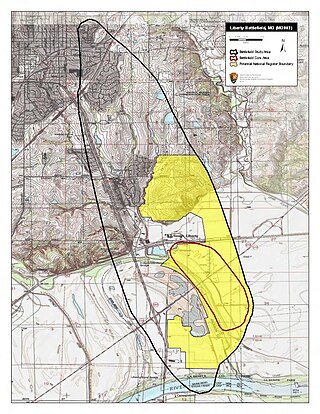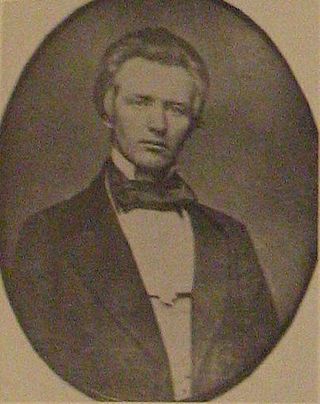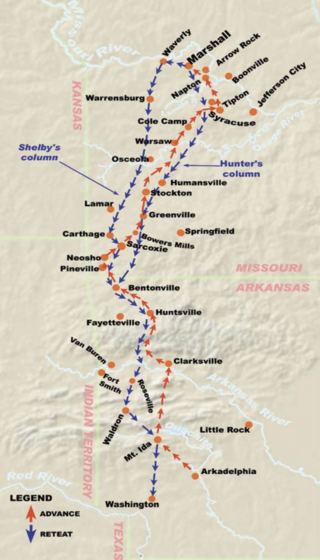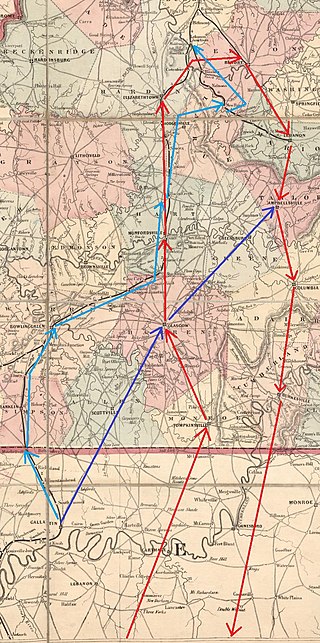The Second Battle of Springfield took place during the American Civil War on January 8, 1863, in Springfield, Missouri. It is sometimes known as The Battle of Springfield. Fighting was urban and house-to-house, which was rare in the war.

The Battle of Carthage, also known as the Engagement near Carthage, took place at the beginning of the American Civil War on July 5, 1861, near Carthage, Missouri. The experienced Colonel Franz Sigel commanded 1,100 Federal soldiers intent on keeping Missouri within the Union. The Missouri State Guard was commanded by Governor Claiborne F. Jackson himself and numbered over 4,000 soldiers led by a hero of Mexico, Sterling Price, along with 2,000 unarmed troops who did not participate in the battle.

Engagement at Fredericktown, also known as the Battle of Fredericktown, was a battle of the American Civil War that took place on October 21, 1861, in Madison County, Missouri. The Union victory consolidated control of southeastern Missouri.

The action at Blue Mills Landing, also known as the Battle of Liberty, was a battle of the American Civil War that took place on September 17, 1861, in Clay County, Missouri. Union forces unsuccessfully attempted to prevent pro-Southern Missouri State Guards from northwestern Missouri from crossing the Missouri River near the confluence with the Blue River to reinforce Sterling Price at Lexington.

Brigadier-General Meriweather Jeff Thompson, nicknamed "Swamp Fox," was an American soldier who was a senior officer of the Missouri State Guard who commanded cavalry in the Trans-Mississippi Theater of the American Civil War. The CSS General M. Jeff Thompson was named after him.

Morgan's Raid was a diversionary incursion by Confederate cavalry into the Union states of Indiana, Kentucky, Ohio, and West Virginia during the American Civil War. The raid took place from June 11 to July 26, 1863. It is named for the commander of the Confederate troops, Brigadier General John Hunt Morgan. Although it caused temporary alarm in the North, the raid failed.

The Missouri State Guard (MSG) was a military force established by the Missouri General Assembly on May 11, 1861. While not a formation of the Confederate States Army, the Missouri State Guard fought alongside Confederate troops and, at various times, served under Confederate officers.

Robert Marcellus Stewart was the 14th Governor of Missouri from 1857 to 1861, during the critical years just prior to the American Civil War.

The Platte River is a tributary of the Missouri River, about 200 miles (320 km) long, in southwestern Iowa and northwestern Missouri in the United States. It is sometimes known as the Little Platte River to distinguish it from the larger Platte River, also a tributary of the Missouri, in nearby Nebraska; the Platte River of Missouri itself has a tributary known as the "Little Platte River".

The Hannibal and St. Joseph Railroad was the first railroad to cross Missouri starting in Hannibal in the northeast and going to St. Joseph, Missouri, in the northwest. It is said to have carried the first letter to the Pony Express on April 3, 1860, from a train pulled behind the locomotive Missouri.

During the American Civil War, Missouri was a hotly contested border state populated by both Union and Confederate sympathizers. It sent armies, generals, and supplies to both sides, maintained dual governments, and endured a bloody neighbor-against-neighbor intrastate war within the larger national war.

Louisville in the American Civil War was a major stronghold of Union forces, which kept Kentucky firmly in the Union. It was the center of planning, supplies, recruiting and transportation for numerous campaigns, especially in the Western Theater. By the end of the war, Louisville had not been attacked once, although skirmishes and battles, including the battles of Perryville and Corydon, Indiana, took place nearby.
The sacking of Osceola was a Kansas Jayhawker initiative on September 23, 1861, to push out pro-slavery Southerners at Osceola, Missouri. It was not authorized by Union military authorities but was the work of an informal group of anti-slavery Kansas "Jayhawkers". The town of 2,077 people was plundered and burned to the ground, 200 slaves were freed and nine local citizens were court-martialed and executed.
Silas M. Gordon (1835–1888) was an anti-United States Federal government guerrilla who indirectly caused Platte City, Missouri, to be burned twice by forces during the American Civil War. The town of Gordonville, Texas, is named for him. Confederate Silas "Si" Gordon was born in Montgomery County, Kentucky in 1835 and moved with his parents, William and Lucretia (Muir) Gordon, to Platte County, Missouri.

The Platte Bridge Railroad Tragedy was a bushwhacker attack on the Hannibal and St. Joseph Railroad during the American Civil War on September 3, 1861, in which the train derailed on a bridge over the Platte River east of St. Joseph, Missouri, killing between 17 and 20 and injuring 100. The bridge crosses the river in Buchanan County, between Marion Township on the east, and Washington Township on the west.
The Bee Creek Massacre occurred in December 1861, when Union Army troops of the 18th Missouri Infantry Regiment summarily executed two Confederate prisoners of war.
W. James Morgan was a Union Army recruiter and officer in the American Civil War.

The Battle of Cynthiana, or more specifically the Second Battle of Cynthiana or the Battle of Kellar's Bridge, included three separate engagements during the American Civil War that were fought on June 11 and 12, 1864, in Harrison County, Kentucky, in and near the town of Cynthiana. This was part of Confederate Brigadier General John H. Morgan's 1864 Raid into Kentucky. The battle ultimately resulted in a victory by Union forces over the raiders and ended Morgan's Last Kentucky Raid in defeat. Morgan's command had previously captured the town in the First Battle of Cynthiana, July 17, 1862.

Shelby's Raid, also known as Shelby's Great Raid, was a Confederate cavalry incursion into Arkansas and Missouri during the American Civil War in 1863. Led by Colonel Joseph Orville Shelby, the raid took place from August 21, 1863, to November 3, 1863, covering over 800 miles across territories in west central and northwest Arkansas, as well as southwest and west central Missouri.

Morgan's Christmas Raid was carried out by Confederate Brigadier General John Hunt Morgan between December 22, 1862, and January 5, 1863. Morgan intended to cut the supply lines to the Union Army of the Cumberland in Tennessee. The Union used the Louisville and Nashville Railroad, and Morgan had identified two 500-foot (150 m) long trestle bridges at Muldraugh Hill that could be burnt. Morgan's 4,000-strong cavalry force left Alexandria, Tennessee, on December 22 and passed into Kentucky on Christmas Eve, defeating part of the 2nd Michigan Cavalry Regiment near Tompkinsville. They fought and defeated an Indiana cavalry detachment on Christmas Day at Bear Wallow, Barren County. The U.S. Army sent forces under Colonel John Marshall Harlan and Major General Joseph J. Reynolds to try to catch Morgan. However, Morgan used ruses to distract his pursuers. Morgan captured a Union stockade at Bonnieville on December 26 and on December 27 captured Elizabethtown before burning the bridges at Muldraugh Hill.














